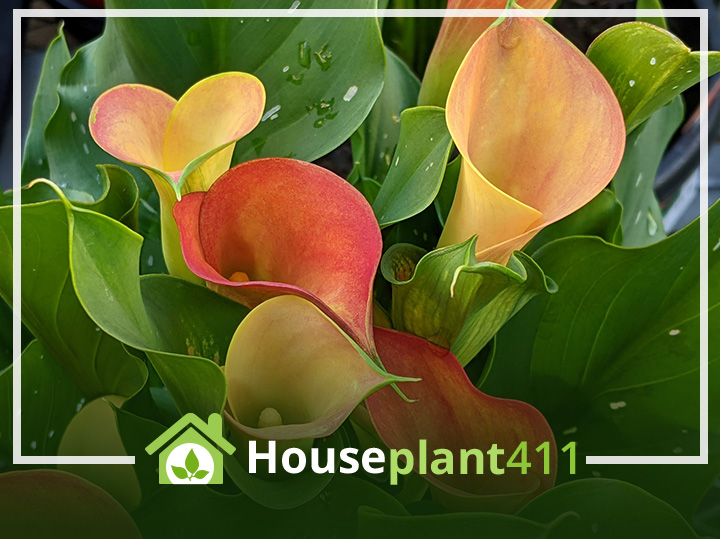About
The Calla Lily plant, Zantedeschia aethiopica, produces beautiful flowers when grown outdoors, planted in the ground in a warm area, or indoors grown in a decorative pot next to a sunny window. This elegant plant, native to the marshes of South Africa, is not a true lily or even in the Lilium family. A Calla Lily is a member of the Araceae family and a relative of the caladium plant. The long-lasting flowers are popular in wedding bouquets where they are a symbol of purity and beauty.
Calla Lily Description
A Calla Lily plant is grown from small rhizomes. A rhizome is a long, thick, modified stem that grows horizontally underground. It produces shoots that grow upwards and out of the soil and roots that grow downwards. Rhizomes, like plant bulbs, not only support the plant but store food and other nutrients. The large, tubular or funnel shaped Calla Lily flowers (spathes), grow atop tall, thick stems and have a finger-like yellow spadix in the center. The flower can be as large as 10″ (25.4cm) long. The long tapered green leaves of the plant may be streaked with faint white or yellow spots. Today, thanks to the many new hybrids developed by breeders throughout the world, Calla Lilies can be found not only in white, but also pink, orange, fuchsia, red, yellow, dark maroon, and cream.
Quick Care Tips for a Calla Lily
Needs bright, indirect light but no direct sun
Keep soil moist but never soggy at all times
Feed every 2 weeks when flowering and monthly when there are only leaves.
Cool temperatures 50°-75°F (10°-24°C)Keep in small pot to encourage more flowers
Plant must have a 2-3 month dormant (rest) period if you want it to flower
Propagate by dividing the rhizomes
Calla Lily Plant Varieties
Zantedeschia aethiopica – “White Calla Lily” – white flowers
Zantedeschia elliottiana – “Golden Calla Lily” bright yellow flowers
Zantedeschia “Picasso” – dark purple flowers with a creamy white border
Zantedeschia “Mango” – peach colored flowers with a dark brown center and green leaves with white spots
Zantedeschia “Captain Amigo” – golden yellow flowers that blend into deep orange and green leaves with white spots
Zantedeschia “Mozart “ – peachy pink flowers and green leaves with white spots
Zantedeschia “Black Star” – dark purple almost black flowers and green leaves with white spots.
Zantedeschia “Captain Romance” deep pink and cream colored flowers and green leaves with white spots




Conclusion
A Calla Lily is a beautiful plant that produces elegant looking flowers. It is well worth the extra time and effort it takes to follow the care tips below, especially when its time for the plant to have a rest and go dormant for a few months. A Calla Lily is a poisonous plant and should be kept way from small children and pets. Read more about common houseplants that can be dangerous in my book Don’t Feed Me to Your Cat: A Guide to Poisonous Houseplants.
Plant Care
Light
Calla Lilies require at least six hours a day of very bright indirect light. Avoid direct sun, especially during the middle of the day, since it will burn the leaves and flowers.
Water
These plants like moist soil at all times. Calla Lilies are not drought resistant and should never be allowed to totally dry out. Keep the soil moist but not soggy. Never allow a Calla Lily to sit in water for more than 15 minutes.
Fertilizer
Fertilize an indoor Calla Lily every two weeks when the plant is flowering with a liquid plant food low in nitrogen. When the plant is producing only leaves and no flowers, fertilize monthly. Always dilute the plant food to ½ the recommended strength. If your Calla Lily is planted outside, use a granular plant food instead of a liquid fertilizer.
Temperature
Room temperatures should be between 50°-75°F (10°-24°C) for optimal growth. Keep Calla Lilies away from heating and air conditioning vents. If planted outdoors, be sure to dig up the Calla Lily bulbs and bring them inside before temperatures dip below freezing.
Humidity
Calla Lilies do well in average humidity.
Flowering
The flowers of a Calla Lily are really spaths similar to those of a Peace Lily but much more impressive. The plant usually blooms for about six weeks during the late spring and early summer. Keeping the plant root- bound encourages more flowers. Calla Lilies may be forced to bloom at any time indoors. The long lasting cut flowers are perfect in bouquets and flower arrangements.
Pests
Examine a Calla Lily frequently for signs of scale or aphids.
Diseases
Calla Lilies are susceptible to various viruses and bacterial infections, especially rhizome rot and gray mold. These problems become evident when leaves and stems start to turn yellow before the plant is normally entering its dormant phase.
Soil
Use a good peat moss based potting soil that is well aerated and drains quickly. You can add builder’s sand or perlite if the soil seems too heavy and clay-like.
Pot Size
Bulbs can be removed from their pots and stored in a cool dark location during their yearly dormant period. After 2-3 months of rest, plant the Calla Lily rhizomes (bulbs) in a clean pot with fresh rich soil. Use deep pots for Calla Lily bulbs, planting one bulb in a five-or six-inch pot, or two or three bulbs in an eight-inch pot. Plant the Calla Lily rhizomes (bulbs) deep enough so that they are covered by at least twice the height of the bulb. Calla Lilies usually bloom about 60 days after the bulbs are planted.
Pruning
Calla Lilies only need to be pruned when they are entering their dormant or resting phase.
Propagation
Callas Lilies can be propagated by division and seeds. The easiest method is to simply divide the rhizomes in the early spring and plant a single rhizome (bulb) in a deep six inch pot. Wait until the plant has started to produce new green leaves before going back to a regular fertilization program.
Resting Period
Calla Lily, a bulb plant, becomes dormant once a year. After the plant has finished blooming, the leaves turn yellow and then brown. Once this occurs prune the plant down to the soil level and put it in a cool dark area where the temperature is above freezing but no higher than 50°F (10°C) for 2-3 months. Keep the soil very dry, watering sparingly every few weeks to prevent the bulbs from drying out. The area where the plant is stored should be low in humidity otherwise the bulbs get moldy and rot. After two or three months, return your Calla Lily to a bright warm spot and start watering. Once green leaves develop, feed with a fertilizer specifically for bulbs at ½ the recommended strength to encourage the new growth. The plant should start to bloom again in 6-8 weeks.
Special Occasion
Calla Lilies are lovely gifts for any occasion.
Poisonous Plant Info
A Calla Lily is a very poisonous houseplant with a #3 toxicity level. Please keep it away from small children and pets. This plant contains high levels of calcium oxalate and ingestion may cause severe burning and swelling of the mouth, throat, lips, and tongue. Stomach distress and diarrhea can also occur.
FAQ
After your Calla Lilies finish blooming you’ll see a seed pod hanging just behind where the flower was. Let the seed pod remain on the plant until it turns yellow and becomes soft. Once you remove the pod, gently break it open and remove the seeds from the inner pulp. If you want to grow Calla Lilies from seed you have to be very patient. Calla Lilies usually take 3 or more years to produce flowers after the seeds are planted.
Calla Lilies take about 12-14 weeks for the flowers to look their best. So I’d recommend planting the bulbs about 3 1/2 months before you plan to use the flowers. Be sure to have a back up flower plan in case the Calla Lilies have a problem and don’t produce the number of blooms you’re hoping for in time for your wedding.
There are several reasons why a Calla Lily produces only leaves and no flowers.
Just the opposite, you should never feed a Calla Lily when it is in bloom. Good quality Calla Lily bulbs do not need much fertilizer so always err on the side of less food rather than more.

